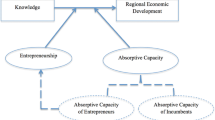Abstract
A new model of economic growth introduces the knowledge filter between new knowledge and economically useful knowledge. It identifies both new ventures and incumbent firms as the mechanisms that penetrate the knowledge filter. Recent empirical work has shown that new firms are more proficient at penetrating the knowledge filter than are incumbent firms; however, the analysis has only examined expanding economies and has relied on purely cross-sectional regression methodologies. This study explores the role of new and incumbent firms in penetrating the knowledge filter utilizing recent developments in spatial panel estimation techniques to provide a more robust set of findings. The results suggest those new firms are more proficient at penetrating the knowledge filter in declining and growing regions alike.
Similar content being viewed by others
References
Acs ZJ, Armington C (2006) Entrepreneurship, geography and american economic growth. Cambridge University Press, Cambridge
Acs ZJ, Audretsch DB (1987) Innovation, market structure, and firm size. Rev Econ Stat 69(4): 567–574
Acs Z, Plummer L (2005) Penetrating the “knowledge filter” in regional economics. Ann Reg Sci 39: 439–456
Acs Z, Varga A (2002) Geography, endogenous growth and innovation. Int Reg Sci Rev 25(1): 132–148
Acs Z, Audretsch D, Braunerhjelm P, Carlsson B (2004) The missing link: the knowledge filter and endogenous growth. Center for Economic Policy Research, London, UK, December, no. 4783
Acs ZJ, Audretsch DB, Braunerhjelm P, Carlsson B (2005) The knowledge spillover theory of entrepreneurship, Center for Economic Policy Research. London, UK, December, no. 5326
Anselin L, Bera A (1988) Spatial dependence in linear regression models with an introduction to spatial econometrics. In: Cummings LL (eds) The handbook of applied economic statistics. Marcel Dekker, New York, pp 237–289
Anselin A, Varga A, Acs Z (1997) Local geographic spillovers between university research and high-technology innovation. J Urban Econ 42: 422–448
Arrow K (1962) The economic implication of learning by doing. Rev Econ Stat 80: 155–173
Audretsch D, Feldman M (1996) R&D spillovers and the geography of innovation and production. Am Econ Rev 86(3): 630–640
Barro RJ, Sala-I-Martin X, Blanchard OJ, Hall RE (1991) Convergence across states and regions. Brookings Pap Econ Act 1: 107–182
Belsley D, Kuh E, Welsch R (1980) Regression diagnostics. Wiley, New York
Bernard AB, Redding SJ, Schott PK (2006) Multi-product firms and product switching. NBER working papers, no. 12293
Braunerhjelm P (1999) Sunk costs, firm Size, and internationalization. Weltwirtsch Archiv 135(4): 657–674
Carlsson B (1999) Small business, entrepreneurship, and industrial dynamics. In: Acs ZJ (eds) Are small firms important? Their role and impact. Kluwer, Boston, pp 99–110
Carlsson B, Fridh A-C (2002) Technology transfer in United States Universities: a survey and statistical analysis. J Evol Econ 12(1–2): 199–232
Carlsson B, Acs ZJ, Audretsch DB, Braunerhjelm P (2007) The knowledge filter, entrepreneurship and economic growth. Case Western Reserve University
Cohen W, Levinthal D (1990) Absorptive capacity: a new perspective on learning and innovation. Adm Sci Q 35(1): 128–152
Elhorst JP (2003) Specification and estimation of spatial panel data models. Int Reg Sci Rev 26: 244–268
Hayek J (1945) The use of knowledge in society. Am Econ Rev 35: 520–530
Henderson VJ (2003) Marshall’s scale economies. J Urban Econ 53(1): 1–28
High S (2003) Industrial sunset: the making of North America’s rust belt, 1969–1984. University of Toronto Press, Toronto
Holtz-Eakin D, Kao C (2003) Entrepreneurship and economic growth: the proof is in the productivity, Center for Policy Research – Working paper no. 50, available at http://www.cpr.maxwell.syr.edu
Jaffe A (1989) The real effects of academic research. Am Econ Rev 79(5): 957–970
Jaffe A, Tratjenberg M, Henderson R (1993) Geographic localization of knowledge spillovers as evidenced by patent citations. Q J Econ 108: 483–499
Jovanovic B (2001) New technology and the small firm. Small Bus Econ 16(1): 53–55
Keller W (2002) Geographic localization of international technology diffusion. Am Econ Rev 92(1): 120–142
Knight F (1921) Risk, uncertainty and profit. Houghton Mifflin, Boston
LeSage JP (1997) Bayesian estimation of spatial autoregressive models. Int Reg Sci Rev 20: 113–129
LeSage JP (1998) Spatial econometrics. http://www.spatial-econometrics.com/html/wbook.pdf
Lucas R (1988) On the mechanics of economic development. J Monet Econ 22: 3–39
Michelacci C (2003) Low returns in R&D due to the lack of entrepreneurial skills. Econ J 113: 207–
Romer P (1986) Increasing returns and economic growth. Am Econ Rev 94: 1002–1037
Romer P (1990) Endogenous technical change. J Pol Econ 98: 71–102
Schumpeter J (1911) Theorie der wirtschaftlichen entwicklung. English translation: The theory of economic development, harvard University Press, Cambridge
Shane S, Eckhardt J (2003) The individual-opportunity Nexus. In: Acs ZJ, Audretsch D. Handbook of entrepreneurship research. Boston, Kluwer, pp 161–194
Utterback JM, Abernathy W (1975) A dynamic model of process and product innovation. Omega 33: 639–656
Varga A (1998) University research and regional innovation. Kluwer, Boston
Author information
Authors and Affiliations
Corresponding author
Rights and permissions
About this article
Cite this article
Acs, Z., Plummer, L.A. & Sutter, R. Penetrating the knowledge filter in “rust belt” economies. Ann Reg Sci 43, 989–1012 (2009). https://doi.org/10.1007/s00168-008-0234-y
Received:
Accepted:
Published:
Issue Date:
DOI: https://doi.org/10.1007/s00168-008-0234-y




